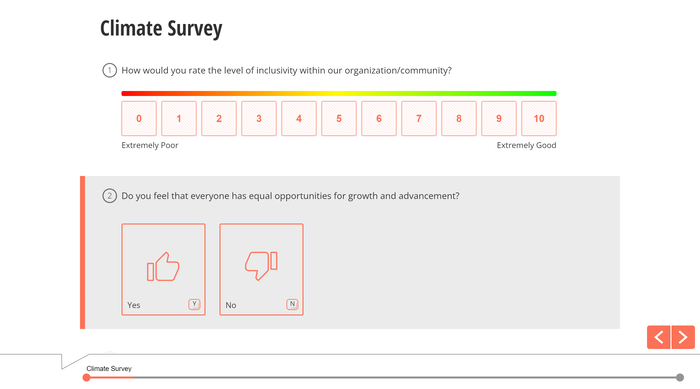Climate surveys are more than questionnaires; they’re the heartbeat of change within organizations and institutions.
In this article, we’ll delve into the definition of climate surveys, their purpose, and how to take action based on their findings.
Table of Contents
What is a climate survey?
Climate surveys are valuable tools used to assess and measure the perceptions, attitudes, and experiences of individuals within an organization or institution.
These often include survey questions that explore topics such as workplace culture, diversity and inclusion, safety, and overall satisfaction.
Offering a comprehensive view of the “climate” within the institution.

What is the purpose of climate surveys?
The primary purpose of climate surveys is to assess and understand the prevailing atmosphere and experiences within an organization or institution.
These surveys provide a platform for individuals to share their perceptions and concerns, fostering inclusivity and equity.
They offer data-driven insights that inform decision-making, pinpoint areas needing improvement, and promote transparency and accountability.
By acting on survey findings, organizations can enhance their culture, boost satisfaction, and create an environment where diverse voices are valued.
In essence, climate surveys are instrumental in driving positive change and progress within institutions.
How do you conduct a climate survey?
Conducting a climate survey is a process that requires careful planning and execution to yield meaningful results.
Feel free to tailor these questions to suit the specific context and goals of your climate survey.
Here are the 10 steps to successfully conduct a climate survey:
1. Define your objective
Start by clearly defining the goals of your survey. What do you want to learn or achieve? Understanding your objectives will guide the entire survey process.
2. Survey design
Develop a well-structured survey instrument that includes a mix of closed-ended questions and open-ended questions. Questions should be clear, concise, and relevant to your objectives.
Consider using established survey rating scales to measure specific factors, such as satisfaction or inclusivity.
3. Target audience
Before launching the survey, conduct a pilot test with a small group to identify any issues with question clarity or survey flow.
Make necessary adjustments based on their feedback.
4. Pilot testing
Identify the target audience for your survey. This could be employees, students, community members, or specific demographic groups within your institution.
Define the sample size and method for selecting participants, ensuring it’s representative of the population.
5. Survey administration
Choose the most appropriate method for survey distribution. This can include online surveys, paper questionnaires, or a combination of both. Ensure that participants have ample time to complete the survey.
Collect responses and store data securely. Monitor response rates to ensure a representative sample.
6. Data analysis
Once data collection is complete, use data analysis tools to identify patterns, trends, and areas of concern. This step is critical in deriving actionable insights from the survey results.
7. Reporting and communication
Share the survey findings with relevant stakeholders, such as employees, students, or board members. Use clear, visual reports to convey the results, highlighting both strengths and areas for improvement.
8. Action planning
Develop action plans based on the survey results. Engage with participants and stakeholders to create strategies for addressing the issues identified in the survey.
9. Follow-up surveys
Conduct follow-up surveys to track progress and measure the impact of the changes implemented as a result of the initial survey.
10. Continuous improvement
Climate surveys should be a part of an ongoing process of continuous improvement. Regularly assess the effectiveness of the measures taken and adjust strategies as needed.
20 questions for climate surveys
To help you gauge the climate of your organization or institution, we’ll provide you 20 example questions for climate surveys below:
Inclusivity
- How would you rate the level of inclusivity within our organization/community?
- Do you feel that everyone has equal opportunities for growth and advancement?
Diversity
- How diverse do you perceive our organization/community to be?
- Are there any specific aspects of diversity that you believe need more attention?
Workplace culture
- On a scale of 1 to 10, how would you rate the overall workplace culture?
- What aspects of our workplace culture contribute most to your job satisfaction?
Communication
- How effective do you find communication within the organization/community?
- Do you feel your opinions and ideas are actively sought and valued?
Safety
- Do you feel safe and secure within our organization/community?
- Are there any safety concerns you believe need immediate attention?
Leadership effectiveness
- How confident are you in the leadership’s ability to guide the organization/community?
- Do you feel leadership is responsive to the needs and concerns of the members?
Training and development
- Are there sufficient opportunities for professional development and training?
- How would you rate the effectiveness of our current training programs?
Work-life balance
- How satisfied are you with the current work-life balance within the organization/community?
- Do you feel supported in maintaining a healthy work-life balance?
Feedback mechanisms
- How satisfied are you with the current work-life balance within the organization/community?
- Do you feel supported in maintaining a healthy work-life balance?
Overall satisfaction
- On a scale from 1 to 10, how satisfied are you with your overall experience within the organization/community?
- What specific changes, if any, would significantly improve your satisfaction?
Wrapping up: Climate surveys
As we conclude our journey into the realm of climate surveys, we’ve unveiled the transformative power these tools hold.
From assessing the heartbeat of an organization to fostering inclusivity and driving data-driven change, climate surveys are the catalysts of positive evolution.
As you start collecting your own feedback, remember that these types of business surveys are not just instruments; they’re pathways to a more inclusive, equitable, and harmonious future. So, armed with insights and a commitment to progress, go forth and shape a brighter tomorrow.
